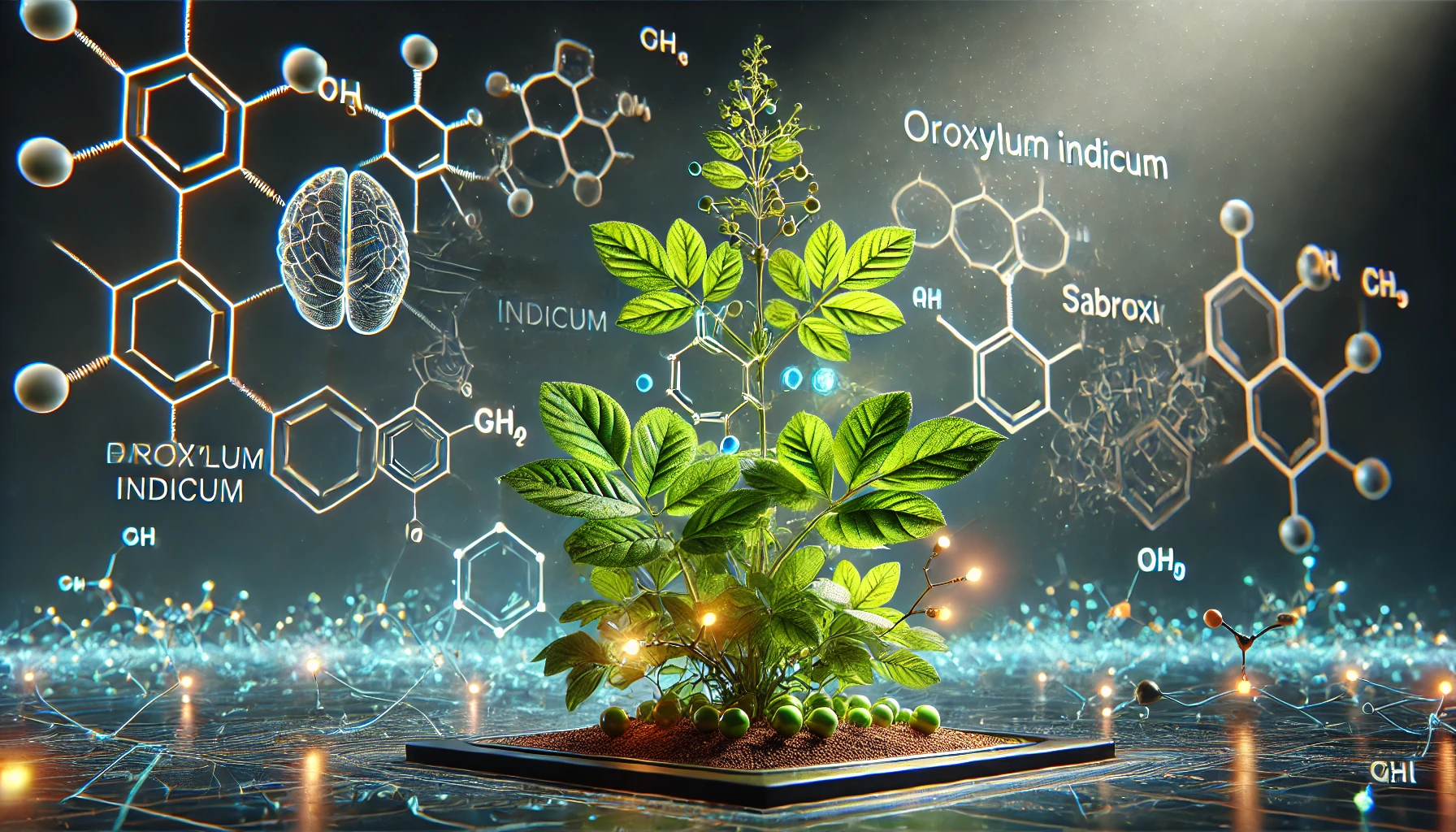

Sensoril® Ashwagandha
- Category: Herbal extracts
Quantity
| Quantity | Discounted price | DISCOUNT |
|---|---|---|
| 3-5 | €24.41 | 5%€1.29 |
| 6-9 | €23.64 | 8%€2.06 |
| 10+ | €23.13 | 10%€2.57 |
Change your country
- Your Biohacking Experts.
- Mo-Fr Same day shipping for orders before 17:00.
- Free shipping for orders above 75eu.
- Superior Quality high purity extracts and compunds.
- Quantity based discounts applicable.
Biohacking Core Sensoril® Ashwagandha Capsules
Product Overview
Biohacking Core offers Sensoril® Ashwagandha, a dietary supplement featuring a patented, standardized botanical extract derived from both the roots and leaves of the Withania somnifera plant. Commonly known as Ashwagandha or Indian ginseng, this adaptogenic herb has a long history of use in traditional Ayurvedic practices.
Sensoril® is specifically processed using an aqueous extraction method to provide a consistent profile of bioactive compounds, primarily withanolide glycosides. This supplement provides Ashwagandha extract in a convenient capsule form.
Key Features
- Features patented Sensoril® Ashwagandha extract (500 mg per capsule).
- Derived from a unique blend of Withania somnifera roots and leaves.
- Standardized to contain ≥ 10% Withanolide Glycosides.
- Triple-standardized extract for consistent quality.
- Aqueous (water) extraction process used.
- Low level of Withaferin A (controlled).
- Non-GMO and suitable for vegans (Vegan capsules).
- 90 capsules per bottle.
Ingredients & Supplement Facts
- Serving Size: 1 vegan capsule
- Servings Per Container: 90
- Amount Per Serving:
- Sensoril® Ashwagandha (Withania somnifera) Root and Leaf Extract: 500 mg
- *(Standardized to ≥ 10% Withanolide Glycosides)*
- Other Ingredients: Vegetable Cellulose (capsule), Microcrystalline Cellulose, Magnesium Stearate, Silicon Dioxide.
Suggested Use
Take 1 capsule, one to two times daily, preferably with water, or as directed by a healthcare professional. Do not exceed the suggested amount.
Quality & Purity Assurance
This product features Sensoril®, a premium, patented Ashwagandha extract developed by Natreon, Inc., known for its scientifically studied Ayurvedic ingredients and rigorous quality control.
- Source: Sensoril® extract is produced from organically farmed Withania somnifera.
- Standardization: Triple-standardized for consistent levels of ≥10% Withanolide Glycosides, Oligosaccharides, and ≤2% Withaferin A.
- Certifications: Sensoril® ingredient holds certifications including Non-GMO, Vegan, Halal, Kosher, and has self-affirmed GRAS status in the USA.
- Manufacturing: Capsules are manufactured in the European Union under strict quality standards, including Good Manufacturing Practice (GMP).
.
Packaging & Storage
- Packaging: 90 vegan capsules per plastic bottle, sealed for freshness.
- Storage: Store in a cool, dry place, away from direct sunlight and moisture. Keep bottle tightly closed. Keep out of reach of children.
Warnings & Cautions
- For adult use only. Not recommended for children, adolescents, pregnant or breastfeeding women.
- Consult your healthcare provider before using this product if you have a medical condition (especially liver conditions or thyroid disorders like hyperthyroidism) or are taking any medications (including thyroid medication, immunosuppressants, sedatives).
- Discontinue use if adverse reactions occur (e.g., gastrointestinal upset, drowsiness, headache; rare reports of liver issues associated with Ashwagandha use have been noted).
- Use caution if combining with alcohol or other sedatives.
- Keep out of reach of children.
- Note: Regulatory status and advice regarding Ashwagandha may vary by country; some EU member states have specific restrictions or warnings.
Disclaimer
This product is a dietary supplement and is not intended to diagnose, treat, cure, or prevent any disease. It should not be used as a substitute for a varied and balanced diet or a healthy lifestyle. Do not exceed the recommended daily dose.
Sources and related content
Ingredient Overview
Ashwagandha (Withania somnifera), sometimes called “Indian ginseng” or “winter cherry”, is a shrub in the nightshade family long used in Ayurvedic medicine17. Traditionally, preparations from its roots (and occasionally leaves) were used for general vitality and to address ailments such as rheumatism, insomnia, and stress1. The name “ashwagandha” in Sanskrit means “smell of the horse,” alluding to the herb’s distinct odor and the belief it imparts the strength of a horse. Sensoril® Ashwagandha is a branded, standardized extract of this plant that combines both root and leaf components. It has gained popularity as a dietary supplement in recent years1, often marketed as an adaptogen (a traditional term for an herb thought to help the body resist stressors). However, while ashwagandha is widely promoted for effects like stress relief and improved sleep, these purported benefits are not officially confirmed by scientific consensus2. In Europe and elsewhere, ashwagandha is available in food supplements (capsules, powders, herbal teas, etc.), but any health claims are under regulatory scrutiny and must comply with strict evidence requirements. Notably, the German Federal Institute for Risk Assessment (BfR) has stated that claimed positive effects (e.g. enhanced performance or stress reduction) have not been conclusively proven2.
Chemical Classification and Structure
Ashwagandha is rich in bioactive phytochemicals. The most studied constituents are withanolides, which are a class of steroidal lactone triterpenes, and several types of alkaloids2. Withanolides are naturally occurring C28 steroidal lactones built on an ergostane (steroid) framework, in which the 22nd and 26th carbon atoms are oxidized to form a five- or six-membered lactone ring5. In simpler terms, these molecules have a multi-ring structure resembling that of steroids (like hormones), with an added oxygen-containing ring (lactone). Dozens of distinct withanolide compounds have been identified in W. somnifera alongside various alkaloids and glycosides2. The withanolide known as withaferin A was one of the first isolated and is often used as a reference for this class. Alkaloids in ashwagandha (such as withanine) are nitrogen-containing compounds; though present in smaller quantities than withanolides, they may also contribute to the plant’s biological activity2. Structure of withaferin A, a representative ashwagandha withanolide. Withaferin A features a four-ring steroid-like core (carbon backbone) with two fused epoxide rings and a lactone ring (at the molecule’s terminus). It also bears several hydroxyl (–OH) groups. This structure exemplifies the withanolide skeleton described above – essentially a modified steroid molecule with a lactone moiety. Such structural similarity to steroid hormones partly explains why withanolides can interact with biological receptors, although they are plant-derived compounds and not produced by the human body.
Dietary Sources
Ashwagandha is not a common dietary nutrient but rather an herbal ingredient obtained from the Withania somnifera plant. The plant is native to arid regions of India and North Africa and is cultivated in parts of the Middle East and Europe7. The root is the primary part used for traditional preparations – often dried, ground into a powder (known as churna in Ayurveda), and consumed in beverages or tonics. The leaves and berries have also been used in certain remedies, though less commonly. In modern food supplements, ashwagandha is available as raw root powder, tea (often marketed as winter cherry tea), or as concentrated extracts. Notably, Sensoril Ashwagandha utilizes both root and leaf material to create its extract2. This approach aims to capture a broader spectrum of phytochemicals. While small amounts of ashwagandha might be taken in herbal teas or traditional dishes in its native regions, it is not typically found in standard diets; consumers generally intake ashwagandha only by purposely taking it as a supplement or herbal preparation. In the European Union, ashwagandha root preparations were introduced as food supplements in recent decades and thus are not considered a novel (new) food under EU regulations (evidence exists of their use in Europe prior to 1997)4. However, the inclusion of ashwagandha in ordinary foods (like adding it to drinks or cereal bars) or the use of novel high-concentration extracts could require additional regulatory approval4.
Biochemical Role and Presence in the Body
Unlike vitamins or minerals, ashwagandha’s compounds have no known nutritional or endogenous role in human biology – the human body does not produce withanolides or require them for any normal function. When a person consumes ashwagandha (such as Sensoril extract), the bioactive molecules act as exogenous (foreign) compounds that can be absorbed and temporarily interact with the body’s biochemistry. Studies have shown that certain withanolides are absorbed into the bloodstream: for example, after oral intake of ashwagandha extracts, measurable levels of withaferin A, withanolide A, and related metabolites appear in human plasma, though typically at low concentrations (in the nanogram-per-milliliter range)6. These phytochemicals may bind to molecular targets; in laboratory and animal studies, withanolides have been observed to modulate signaling pathways related to inflammation, stress response, and hormone signaling. Indeed, high-dose ashwagandha extracts in research settings have been noted to influence hormone levels (for instance, potentially lowering cortisol, or affecting thyroid hormone levels)2. It is important to emphasize that such biochemical actions are still being investigated and are not equivalent to an essential physiological role. Essentially, ashwagandha’s constituents behave like pharmacologically active plant compounds (similar to how caffeine from coffee or curcumin from turmeric interact with the body) rather than nutrients. They are metabolized and cleared after exerting any transient effects. No deficiency of ashwagandha occurs in the body, and currently there is no established biochemical role that these compounds play in normal human metabolism. Any reported effects (e.g. feeling calmer or changes in certain biomarkers) are pharmacodynamic in nature and should not be misconstrued as ashwagandha being “required” for health.
Metabolism and Excretion
After ingestion, the withanolide glycosides and other constituents in Sensoril Ashwagandha must pass through the digestive tract and liver, where they undergo metabolism. Pharmacokinetic studies in animals and humans indicate that withanolides are absorbed but are relatively rapidly eliminated from the body. In humans, the peak blood levels of major withanolides tend to occur within a couple of hours of oral intake, and their half-life (the time for blood levels to drop by half) is on the order of only a few hours for most components6. For example, one report found withaferin A had a half-life of around 1–2.7 hours in human subjects (though in some animal studies, at very high doses, half-lives up to ~7 hours were observed)6. This relatively quick clearance suggests the body efficiently processes and excretes these compounds. Metabolism of ashwagandha’s chemicals primarily occurs in the liver via enzymes that modify the withanolide structure to make it more water-soluble. Researchers have identified multiple metabolites of withaferin A formed by human liver microsomes (including products of hydroxylation and hydrolysis reactions)6. Withanolide glycosides (sugar-conjugated forms) may be hydrolyzed in the gut; notably, an experiment in mice showed that an orally administered withanolide glycoside (withanoside IV) was not detected in plasma as the intact molecule – instead, its aglycone (de-sugarated) metabolite called sominone appeared, indicating conversion by intestinal or hepatic enzymes6. After these Phase I metabolic transformations (and likely Phase II conjugation such as glucuronidation, though direct evidence is limited), the metabolites are excreted. Excretion pathways have not been studied in detail for every compound, but by analogy to other steroidal plant compounds, it is presumed that metabolites are eliminated via the kidneys (urine) and in bile/feces6. In one human trial, small amounts of unchanged withanolides could be measured in plasma and were largely cleared within 24–48 hours6. No bioaccumulation of withanolides is expected with typical dosing. In summary, the body treats ashwagandha’s constituents in the way it would many plant-derived xenobiotics: absorbing what it can, chemically modifying them in the liver, and then excreting the products, usually within a day or so of ingestion.
Industrial Production Methods
Sensoril Ashwagandha is produced through specialized extraction techniques to ensure a consistent profile of active constituents. In general, ashwagandha raw material (the dried roots, and in Sensoril’s case also the leaves) is subjected to an aqueous extraction process. Sensoril is described as a “true aqueous extract,” meaning water is used as the solvent to draw out soluble phytochemicals from the plant matter9. In manufacturing, the roots and leaves are harvested from selected W. somnifera chemotypes (cultivars bred for high withanolide content and low undesirable components). After cleaning and drying, the plant material is boiled or percolated in water to extract compounds like withanolide glycosides. The liquid extract is then filtered to remove insoluble fibers (the process yields a product with almost no root fiber residue, improving its solubility and taste)9. The filtered extract may be concentrated under low heat and finally spray-dried or vacuum-dried to produce a fine powder. This powder can be used in capsules, tablets, or blended into functional foods and beverages. By including both leaves and roots in the input, Sensoril’s production captures a broader spectrum of phytochemicals than root-alone extracts9. (Leaves of W. somnifera contain some withanolides that differ from those in roots, so the combination is thought to provide a more comprehensive chemical profile.) Crucially, the finished Sensoril extract is standardized to specific marker compounds to ensure batch-to-batch consistency. The manufacturer’s specification guarantees a certain minimum percentage of withanolide content (primarily in the form of withanolide glycosides). Published reports and technical data indicate Sensoril typically contains ≥8–10% withanolide glycosides by weight7. At the same time, levels of withaferin A – a particular withanolide that, while bioactive, is considered undesirable in excess due to its cytotoxicity in cell studies – are limited to very low levels (often ≤1–2%) in Sensoril7. The extract naturally includes various oligosaccharides (plant-derived carbohydrates) which can serve as carriers; in Sensoril these are often around 30–40% of the extract7. No synthetic additives are required in the pure powder, as the plant’s own components help form a free-flowing, stable powder. Quality control in industrial production involves testing the extract for total withanolides (by HPLC or similar analytical methods) and verifying the absence of contaminants (like heavy metals, pesticide residues, or microbial load). Sensoril’s producer has achieved self-affirmed GRAS (Generally Recognized As Safe) status in the United States for this extract9, indicating that experts consider it safe for use in foods under intended conditions. Multiple certifications such as non-GMO, organic, kosher, and halal are often obtained to meet global market standards9. From an industrial standpoint, the manufacturing process of Sensoril is designed to yield a water-soluble, concentrated ashwagandha ingredient that can be easily incorporated into capsules or blended into beverages without solubility issues. The use of water as the solvent aligns with traditional preparation methods (Ayurvedic texts often involve boiling ashwagandha in milk or water) but on a modern, scaled and standardized level.
Safety and Recommended Dosages
Recommended Dosages: There is no official EU-sanctioned daily allowance or limit for ashwagandha at this time. Traditional usage provides a reference point: The World Health Organization’s monograph (2009) on medicinal plants notes a typical dose of W. somnifera root is about 3–6 grams of dried root per day when taken as a powder3. In the context of standardized extracts, this often corresponds to roughly 300–500 mg of an extract taken one or two times daily (since extracts are concentrated). In fact, the WHO monograph specifically mentions 250 mg of an ashwagandha extract, taken twice daily (total 500 mg/day), as used for “antistress” purposes traditionally3. Many modern ashwagandha supplements fall in line with these ranges. Sensoril Ashwagandha in particular is formulated to be efficacious at relatively low doses; common commercial products provide on the order of 125–250 mg of Sensoril® per serving. Clinical studies on Sensoril have tested doses from 125 mg per day up to 1,000 mg per day in divided doses7. For example, some trials in adults have used 500 mg twice daily (1,000 mg/day) of Sensoril with no serious adverse effects noted in the short term7. Manufacturers often recommend starting with 250–500 mg per day. It must be emphasized that these amounts are guidelines from traditional use and manufacturer suggestions – they are not “approved” dosages in a regulatory sense. Safety Profile: Overall, ashwagandha is generally well tolerated in the doses used in supplements, but it is not without potential side effects or risks. Mild to moderate side effects have occasionally been reported, especially at higher intakes. These include gastrointestinal upset (such as nausea, stomach cramps, diarrhea) and mild sedation or drowsiness in some individuals2. Headache and dizziness have also been noted in a few cases2. Such effects are usually transient and resolve when the supplement is discontinued. Because ashwagandha can have a calming effect for some, it may enhance the effects of other sedatives or alcohol, so caution is advised if taking it alongside substances that affect the central nervous system. More seriously, there have been isolated reports of liver injury in people taking ashwagandha supplements2. Since 2017, a handful of case studies in Europe and elsewhere documented acute hepatitis (liver inflammation) temporally associated with ashwagandha use. In most reported cases, the individuals recovered after stopping the supplement, and the mechanism of injury remains unclear (an idiosyncratic reaction is suspected). Such cases are rare given the wide usage, but they have prompted authorities to advise vigilance. Ashwagandha may also affect thyroid function2. The herb’s ability to potentially stimulate thyroid hormone activity has been observed in animal studies and a few human trials. In susceptible individuals, high doses might elevate thyroid hormone levels (there have been reports of thyrotoxicosis – excess thyroid hormone – in a couple of persons using ashwagandha). For this reason, anyone with hyperthyroidism or on thyroid medication should use caution and medical supervision if consuming ashwagandha. Given the above, several national agencies have issued contraindications or precautionary advice. The BfR in Germany recommends that certain populations avoid ashwagandha supplements entirely, as a precaution2. These groups include: children and adolescents, due to lack of safety data in developing bodies; pregnant or breastfeeding women, because of the herb’s historical use as an abortifacient and insufficient data on safety for the fetus/infant; and people with pre-existing liver conditions (since any additional stress on the liver could be harmful if there is a susceptibility)2. Additionally, individuals on medications that affect the immune system or hormone systems should be careful – for example, ashwagandha might theoretically interact with immunosuppressants, or with medications for diabetes or blood pressure (due to its mild blood sugar and blood pressure-lowering observations in some studies). Healthcare providers often advise stopping ashwagandha use before surgery or if any abnormal symptoms develop. No health-based guidance value (such as an Acceptable Daily Intake) has been officially established by EFSA or other bodies, because current data are not sufficient3. In 2020, the Danish Technical University (DTU) could not determine a safe lower limit of intake based on available evidence1, indicating that we don’t yet know at what dose absolutely no effects occur. This does not mean ashwagandha is extraordinarily dangerous – rather, it reflects a lack of long-term safety studies. Most clinical trials have been 8–12 weeks in duration, so the effects of taking Sensoril Ashwagandha daily for many months or years are not fully studied. Until more data are available, a conservative approach is prudent. Consumers are advised to stay within dosage recommendations provided by reputable manufacturers and to consult a healthcare professional especially if they have underlying health conditions or take other drugs. Starting with a low dose and monitoring one’s own response is wise. It is also recommended to take breaks (e.g. not using the supplement continuously all year) unless advised otherwise by a doctor. By adhering to these precautions, and sourcing ashwagandha from high-quality producers who test their products, the risk of adverse effects can be minimized.
Conclusion
Sensoril Ashwagandha represents a nutritionally utilized plant extract with a rich heritage and a complex profile of natural compounds. Chemically, it is defined by steroidal lactones (withanolides) and other phytochemicals that, while not needed for any bodily function, can interact with human biochemical pathways in notable ways. This overview has detailed how those compounds are classified and metabolized, as well as how the extract is produced to ensure consistency and safety. Historically prized in traditional medicine, ashwagandha has now come under modern scientific and regulatory examination. Current evidence has not established any clinically proven health benefits that would be accepted by EU regulators2, and safety assessments are ongoing to pin down appropriate usage levels. From a regulatory standpoint, Sensoril Ashwagandha and similar products must be marketed carefully: they are generally permitted as food supplements in the EU, but claims of medicinal or physiological benefits are prohibited without approval, and some countries have set their own restrictions reflecting a cautious approach. For the average consumer, the key takeaways are that Sensoril is a well-characterized, quality-controlled form of ashwagandha, and it should be used responsibly, in moderation, and with awareness that its status is that of a supportive dietary supplement rather than a cure-all.
1. Kirstin Knight (Vitafoods Insights). (2023, April 20). “EU regulatory update on ashwagandha.” Vitafoods Insights. (Overview of evolving EU regulatory landscape regarding Ashwagandha.)
2. German Federal Institute for Risk Assessment (BfR). (2024, September 10). “Ashwagandha: food supplements with potential health risks.” BfR Communication. (Highlights potential safety concerns and regulatory stance in Germany.)
3. National Institute for Public Health and the Environment (RIVM, Netherlands). (2024). Risk assessment of herbal preparations containing Withania somnifera (Ashwagandha). RIVM Report 2024-0029. (Assesses toxicological and regulatory profile for Ashwagandha-based supplements.)
4. NutraIngredients. (2024, March 15). “Novel Foods confusion leading to innovation graveyard, expert warns.” NutraIngredients.com. (Discussion of the Novel Foods regulation and its impact on botanical ingredient innovation.)
5. Sangwan, N.S., Chaurasiya, N.D., Misra, L., et al. (2014). “Withanolides from Withania somnifera Dunal: development of cellular technology and their production.” Recent Patents on Biotechnology 8(1): 25–35. (Focuses on withanolide biosynthesis and biotechnology applications.)
6. Speers, A.B., Kolb, A., et al. (2024). “Quantifying Withanolides in Plasma: Pharmacokinetic Studies and Analytical Methods.” Metabolites 14(1): 27. (Presents methodology for detecting withanolides in blood and pharmacokinetic profiling.)
7. Mikulska, P., Gromek, M., Nowak, A., & Grzybek, M. (2023). “Ashwagandha (Withania somnifera) – Current Research on the Health-Promoting Activities: A Narrative Review.” Pharmaceutics 15(4): 1057. (Narrative summary of pharmacological effects and traditional uses.)
8. Food Standards Agency (UK). (2023). Ashwagandha – Call for evidence on safety. (Official notice inviting submissions on potential risks associated with Ashwagandha in the UK.)
9. Kerry Ingredients. (2024). Sensoril® Ashwagandha Technical Brochure – Root & Leaf Extract Data Sheet. (Supplier technical document on composition, extraction method, and suggested applications.)
10. Wikimedia Commons. (2025). Withaferin A molecule structure (image PNG). (Depicts molecular structure of a key bioactive compound in Ashwagandha.)
Latest Blogs
Stay Informed, Stay Ahead: Discover the Latest Insights in Biohacking

Sabroxy®: Research, Benefits & Effects
Sabroxy® is a relatively new product on the market that's been making some headlines recently. Unlike many popular nootropics, Sabroxy®...
Read More
Biohacking & Neurogenesis: The Essential Connection
Biohacking, or DIY biology, is a buzzword that was popularized over the past decade. In the literal sense of the...
Read More
PrimaVie® Shilajit: Research, Benefits & Effects
The market is full of countless substances touted for their positive impact on brain health, cognition, mood, energy levels, and...
Read More
Social Anxiety & Nootropics: Can They Help?
Regardless of who you are, how confident you consider yourself to be, or how much you communicate with others, you've...
Read More
Biohacking 101: What Is It and Why It Matters
While the term “biohacking” has gained momentum in recent years, its meaning can differ depending on the context in which...
Read More
Vitamin C & Brain Health: Optimize Your Intake
Like most, you’ve probably sought the assistance of compounds to optimize your cognition and brain health. Maybe you struggle with...
Read More
Level Up: Unearth Our Unsurpassed Quality!
CONTACT

4 reviews
Ashwagandha helped me feel calmer after a busy day at work. Definitely recommend for relaxation.
Since starting Ashwagandha, I'm sleeping more soundly and wake up refreshed. Great supplement!
Ashwagandha heeft mijn stressniveau flink verlaagd. Ik slaap rustiger en voel me overdag ontspannen.
Na twee weken merkte ik dat Ashwagandha mijn stemming verbeterde. Ik voel me minder prikkelbaar.
Only logged in customers who have purchased this product may leave a review.